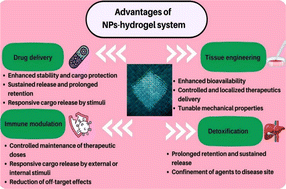
RSC Advances
Subject area
Microbiology articles published in the last
6 months

MOF@platelet-rich plasma antimicrobial GelMA dressing: structural characterization, bio-compatibility, and effect on wound healing efficacy
PRP was adsorbed onto MOF and then added to GelMA to promote the effects on cross-linking degree, mechanical and biological properties of GelMA.

RSC Adv., 2024,14, 30055-30069
https://doi.org/10.1039/D4RA04546G
Synthesis of colicin Ia neoglycoproteins: tools towards glyco-engineering of bacterial cell surfaces
Herein we demonstrate organocatalyst-mediated protein aldol ligation (OPAL) modification of the bacteriocidin colicin Ia to afford mannose-presenting neoglycoproteins with potential utility for non-genetic glyco-engineering of E. coli cell surfaces.

RSC Adv., 2024,14, 29106-29112
https://doi.org/10.1039/D4RA04774E
Bioreceptor modified electrochemical biosensors for the detection of life threating pathogenic bacteria: a review
The lack of reliable and efficient techniques for early monitoring to stop long-term effects on human health is an increasing problem as the pathogenesis effect of infectious bacteria is growing continuously.

RSC Adv., 2024,14, 28487-28515
https://doi.org/10.1039/D4RA04038D
Amelioration of gold nanoparticles mediated through Ocimum oil extracts induces reactive oxygen species and mitochondrial instability against MCF-7 breast carcinoma
The bottom-up synthesis of gold nanoparticles (AuNPs) using Ocimum sanctum essential oil extracts exhibited excellent antimicrobial and therapeutic potential against MCF 7 breast carcinoma through flow cytometry analysis and DNA damage studies.

RSC Adv., 2024,14, 27816-27830
https://doi.org/10.1039/D4RA04807E
Design and synthesis of non-hydroxamate lipophilic inhibitors of 1-deoxy-D-xylulose 5-phosphate reductoisomerase (DXR): in silico, in vitro and antibacterial studies
We report the design, synthesis, and evaluation of the lipophilic DXR inhibitors as potential antimicrobial agents by replacing the hydroxamate metal-binding groups with other metal chelators.

RSC Adv., 2024,14, 27530-27554
https://doi.org/10.1039/D4RA05083E
Engineering Escherichia coli with a symbiotic plasmid for the production of phenylpyruvic acid
An engineered Escherichia coli strain was constructed, and the plasmid copy number remained stable without antibiotic selection pressure. This work extends the production methods for whole-cell biotransformation.

RSC Adv., 2024,14, 26580-26584
https://doi.org/10.1039/D4RA03707C
Inhibition of apoptosis and biofilm formation in Candida auris by click-synthesized triazole-bridged quinoline derivatives
Candida auris, a recent addition to the Candida species, poses a significant threat with its association to numerous hospital outbreaks globally, particularly affecting immunocompromised individuals.

RSC Adv., 2024,14, 21190-21202
https://doi.org/10.1039/D4RA03728F
Exploration of novel cationic amino acid-enriched short peptides: design, SPPS, biological evaluation and in silico study
Antimicrobial resistance (AMR) represents a critical challenge worldwide, necessitating the pursuit of novel approaches to counteract bacterial and fungal pathogens.

RSC Adv., 2024,14, 17710-17723
https://doi.org/10.1039/D3RA08313F
Development of phenyllactic acid ionic liquids and evaluation of cytotoxicity to human cervical epithelial cells
Biocompatible cations can transform phenyllactic acid (PLA), a natural broad-spectrum antimicrobial compound, into ionic liquids (ILs) with greater aqueous solubility.

RSC Adv., 2024,14, 16083-16092
https://doi.org/10.1039/D4RA01812E
Unleashing the promise of emerging nanomaterials as a sustainable platform to mitigate antimicrobial resistance
The emergence and spread of antibiotic-resistant (AR) bacterial strains and biofilm-associated diseases have heightened concerns about exploring alternative bactericidal methods.

RSC Adv., 2024,14, 13862-13899
https://doi.org/10.1039/D3RA05816F
Nanoparticles incorporated hydrogels for delivery of antimicrobial agents: developments and trends
Nanoparticle-hydrogel systems are versatile biomaterials that possess numerous advantages for biomedical applications. This review focuses on the application of the nanoparticle-hydrogels system for the delivery of antimicrobial agents.

RSC Adv., 2024,14, 13535-13564
https://doi.org/10.1039/D4RA00631C
Browse by Subject
- All (374 articles)
- Atomic/elemental (21 articles)
- Bioanalytical (61 articles)
- Chemometrics (37 articles)
- Crystallography (162 articles)
- Electroanalytical (57 articles)
- Imaging/microscopy (33 articles)
- Mass spectrometry (33 articles)
- Medical diagnostics (90 articles)
- Microfluidics (18 articles)
- Nanoanalysis (24 articles)
- Separation science (44 articles)
- Spectroscopy (104 articles)
- All (320 articles)
- Bioinorganic chemistry (79 articles)
- Bioorganic chemistry (21 articles)
- Biotechnology (60 articles)
- Cellular chemistry (70 articles)
- Computational (83 articles)
- Drug delivery (90 articles)
- Drug discovery (214 articles)
- Imaging/diagnostics (14 articles)
- Molecular biology (4 articles)
- Nanotechnology (58 articles)
- Natural products (25 articles)
- Pharmacology (112 articles)
- Photobiology (15 articles)
- Polymorphism (pharma) (2 articles)
- Structural biology (6 articles)
- Toxicology (9 articles)
- All (620 articles)
- Biomaterials (136 articles)
- Biopolymers (117 articles)
- Carbon materials (108 articles)
- Composites (273 articles)
- Electronic materials (79 articles)
- Encapsulation (1 article)
- Energy applications (83 articles)
- Films/membranes (91 articles)
- Gels & soft matter (34 articles)
- Inorganic materials (48 articles)
- Medical materials (97 articles)
- Nanomaterials (150 articles)
- Optical materials (63 articles)
- Organic materials (55 articles)
- Polymers (159 articles)
- All (386 articles)
- Assembly (20 articles)
- Biotechnology (37 articles)
- Carbon nanomaterials (84 articles)
- Imaging/microscopy (17 articles)
- Nanoanalysis (40 articles)
- Nanocatalysis (34 articles)
- Nanomaterials (224 articles)
- Nanomedicine (54 articles)
- Nanotoxicology (67 articles)
- Optical nanomaterials (48 articles)
- Synthesis (23 articles)
- All (188 articles)
- Bioorganic (20 articles)
- Catalysis (53 articles)
- Fine chemicals (20 articles)
- Natural products (22 articles)
- Physical organic (9 articles)
- Stereochemistry (11 articles)
- Supramolecular (3 articles)
- Sustainable synthesis (34 articles)
- Synthetic methodology (107 articles)
- Total synthesis (11 articles)
- All (322 articles)
- Biophysics (5 articles)
- Charge transfer (28 articles)
- Electrochemistry (15 articles)
- Energy research (21 articles)
- Imaging/microscopy (2 articles)
- Kinetics & dynamics (45 articles)
- Materials (108 articles)
- Mechanics (34 articles)
- Nanoscience (78 articles)
- Photoscience (28 articles)
- Quantum & theoretical (105 articles)
- Simulations (34 articles)
- Single molecules (36 articles)
- Soft matter (6 articles)
- Spectroscopy (5 articles)
- Surfaces & interfaces (65 articles)